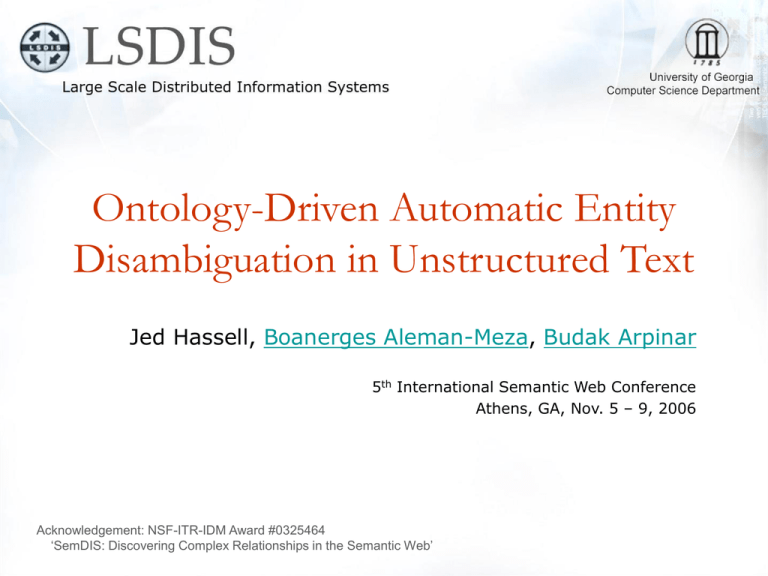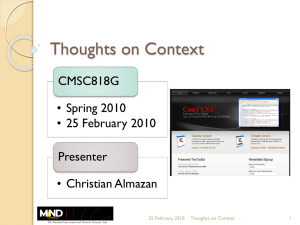Ontology-Driven Automatic Entity Disambiguation in Unstructured Text Jed Hassell, ,
advertisement

Ontology-Driven Automatic Entity Disambiguation in Unstructured Text Jed Hassell, Boanerges Aleman-Meza, Budak Arpinar 5th International Semantic Web Conference Athens, GA, Nov. 5 – 9, 2006 Acknowledgement: NSF-ITR-IDM Award #0325464 ‘SemDIS: Discovering Complex Relationships in the Semantic Web’ The Question is … • How to determine the most likely match of a named-entity in unstructured text? • Example: Which “A. Joshi” is this text referring to? • out of, say, 20 candidate entities (in a populated ontology) 2 “likely match” = confidence score • Idea is to spot entity names in text and assign each potential match a confidence score • The confidence score represents a degree of certainty that a spotted entity refers to a particular object in the ontology 3 Our Approach, three steps 1. Spot Entity Names - assign initial confidence score 2. Adjust confidence score using: - proximity relationships (text) co-occurrence relationships (text) connections (graph) popular entities (graph) 3. Iterate again to propagate result - finish when confidence scores are not updated 4 Spotting Entity Names • Search document for entity names within the ontology • Each match becomes a “candidate entity” • Assign initial confidence scores 5 Using Text-proximity Relationships • Relationships that can be expected to be in near text-proximity of the entity – Measured in terms of character spaces 6 Using Co-occurrence Relations • Similar to text-proximity with the exception that proximity is not relevant i.e., location within the document does not matter 7 Using Popular Entities (graph) • Intention: bias the right entity to be the most popular entity • This should be used with care, depending on the domain • good for tie-breaking • DBLP scenario: entity with more papers • e.g., only two “A. Joshi” entities with >50 papers 8 Using Relations to other Entities • Entities can be related to one another through their collaboration network – ‘neighboring’ entities get a boost in their confidence score • i.e., propagation – This is the ‘iterative’ step in our apprach, • It starts with entities having highest confidence score – Example: “Conference Program Committee Members:” - Professor Smith - Professor Smith’s co-editor in recent book - Professor Smith’s recently graduated Ph.D advisee ......... 9 In Summary, ontology-driven • Using “clues” – from the text where the entity appears – from the ontology Example: RDF/XML snippet of a person’s metadata 10 Overview of System Architecture 11 Once no more iterations are needed • Output of results: XML format – – – – URI Confidence score Entity name (as it appears in the text) Start and end position (location in a document) • Can easily be converted to other formats – Microformats, RDFa, ... 12 Sample Output 13 Sample Output - Microformat 14 Evaluation: Gold Standard Set • We evaluate our method using a gold standard set of documents – Randomly chose 20 consecutive post from DBWorld – Set of manually disambiguated documents (two) humans validated the ‘right’ entity match – We used precision and recall as the measurement of evaluation for our system 15 Evaluation, sample DBWorld post 16 Sample disambiguated document 17 Using DBLP data as ontology • Converted DBLP’s bibliographic data to RDF – – – – 447,121 authors A SAX parser to convert DBLP’s XML data to RDF Created relationships such as “co-author” Added • Affiliations (for a subset of authors) • Areas of interest (for a subset of authors) • spellings for international characters • Lessons learned lead us to create SwetoDblp (containing many improvements) [SwetoDblp] http://lsdis.cs.uga.edu/projects/semdis/swetodblp/ [DBLP] http://www.informatik.uni-trier.de/~ley/db/ 18 Evaluation, Precision & Recall • We define set A as the set of unique names identified using the disambiguated dataset (i.e., exact results) • We define set B as the set of entities found by our method • A B represents the set of entities correctly identified by our method 19 Evaluation, Precision & Recall • Precision is the proportion of correctly disambiguated entities with regard to B • Recall is the proportion of correctly disambiguated entities with regard to A 20 Evaluation, Results • Precision and recall (compared to gold standard) Correct Disambiguation Found Entities Total Entities Precision Recall 602 620 758 97.1% 79.4% • Precision and recall on a per document basis: Precision and Recall 100 90 80 Percentage 70 60 Recall 50 Precision 40 30 20 10 21 0 1 2 3 4 5 6 7 8 9 10 11 12 Documents 13 14 15 16 17 18 19 20 Related Work • Semex Personal Information Management: – The results of disambiguated entities are propagated to other ambiguous entities, which could then be reconciled based on recently reconciled entities (much like our work does) – Takes advantage of a predictable structure such as fields where an email or name is expected to appear • Our approach works with unstructured data [Semex] Dong, Halevy, Madhaven, SIGMOD-2005 22 Related Work • Kim – Contains an entity recognition portion that uses natural language processing – Evaluations performed on human annotated corpora • SCORE Technology (now, http://www.fortent.com/) – Uses associations from a knowledge base, yet implementation details are not available (commercial product) [Kim] Popov et al., ISWC-2003 [SCORE] Sheth et al, Internet Computing, 6(4), 2002 23 Conclusions • Our method uses relationships between entities in the ontology to go beyond traditional syntactic-based disambiguation techniques • This work is among the first to successfully use relationships for identifying named-entities in text without relying on the structure of the text 24 Future Work • Improvements on spotting – e.g., canonical names (Tim = Timothy) • Integration/deployment as a UIMA component • allows analysis along a document collection • for applications such as semantic annotation and search • Further evaluations – – – – Using different datasets and document sets Compare with respect to other methods, and to determine best contributing factor in disambiguation measure how far in the list we missed the ‘right’ entity [UIMA] IBM’s Unstructured Information Management Architecture 25 Scalability, Semantics, Automation • Usage of background knowledge in the form of a (large) populated ontology • Flexibility to use a different ontology, but, – the ontology must ‘fit’ the domain • It’s an ‘automatic’ approach, yet … – Human defines threshold values (and some weights) 26 References 1. 2. 3. 4. 5. 6. 7. Aleman-Meza, B., Nagarajan, M., Ramakrishnan, C., Ding, L., Kolari, P., Sheth, A., Arpinar, B., Joshi, A.,Finin, T.: Semantic Analytics on Social Networks: Experiences in Addressing the Problem of Conflict of Interest Detection. 15th International World Wide Web Conference, Edinburgh, Scotland (2006) DBWorld. http://www.cs.wisc.edu/dbworld/ April 9, 2006. Dong, X. L., Halevy, A., Madhaven, J.: Reference Reconciliation in Complex Information Spaces. Proc. of SIGMOD, Baltimore, MD. (2005) Ley, M.: The DBLP Computer Science Bibliography: Evolution, Research Issues, Perspectives. Proc. of the 9th International Symposium on String Processing and Information Retrieval, Lisbon, Portugal (Sept. 2002) 1-10 Popov, B., Kiryakov, A., Kirilov, A., Manov, D., Ognyanoff, D., Goranov, M.: KIM - Semantic Annotation Platform. Proc. of the 2nd Intl. Semantic Web Conf, Sanibel Island, Florida (2003) Sheth, A., Bertram, C., Avant, D., Hammond, B., Kochut, K., Warke, Y.: Managing semantic content for the Web. IEEE Internet Computing, 6(4) (2002) 80-87 Zhu, J., Uren, V., Motta, E.: ESpotter: Adaptive Named Entity Recognition for Web Browsing, 3rd Professional Knowledge Management Conference, Kaiserslautern, Germany, 2005 Evaluation datasets at: http://lsdis.cs.uga.edu/~aleman/publications/Hassell_ISWC2006/ 27



